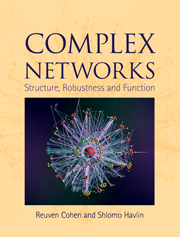Book contents
- Frontmatter
- Contents
- 1 Introduction
- PART I RANDOM NETWORK MODELS
- PART II STRUCTURE AND ROBUSTNESS OF COMPLEX NETWORKS
- PART III NETWORK FUNCTION: DYNAMICS AND APPLICATIONS
- 13 Optimization of the network structure
- 14 Epidemiological models
- 15 Immunization
- 16 Thermodynamic models on networks
- 17 Spectral properties, transport, diffusion and dynamics
- 18 Searching in networks
- 19 Biological networks and network motifs
- Appendix A Probability theoretical methods
- Appendix B Asymptotics and orders of magnitude
- Appendix C Algorithms for network simulation and investigation
- References
- Index
16 - Thermodynamic models on networks
from PART III - NETWORK FUNCTION: DYNAMICS AND APPLICATIONS
Published online by Cambridge University Press: 05 August 2013
- Frontmatter
- Contents
- 1 Introduction
- PART I RANDOM NETWORK MODELS
- PART II STRUCTURE AND ROBUSTNESS OF COMPLEX NETWORKS
- PART III NETWORK FUNCTION: DYNAMICS AND APPLICATIONS
- 13 Optimization of the network structure
- 14 Epidemiological models
- 15 Immunization
- 16 Thermodynamic models on networks
- 17 Spectral properties, transport, diffusion and dynamics
- 18 Searching in networks
- 19 Biological networks and network motifs
- Appendix A Probability theoretical methods
- Appendix B Asymptotics and orders of magnitude
- Appendix C Algorithms for network simulation and investigation
- References
- Index
Summary
Introduction
In this chapter we consider the behavior of some thermodynamic models on networks. Thermodynamic models attempt to describe the macroscopic (large-scale) properties of systems by their microscopic (small-scale) behavior. The microscopic behavior stems from the interactions between atoms or molecules in the material. In the nineteenth century a new branch in physics, called “statistical physics” or “statistical mechanics” appeared (mainly owing to the works of Gibbs, Maxwell and Boltzmann as well as later works by Einstein), which tried to explain the observed properties of materials (phase transitions, magnetism, heat capacity, pressure and temperature) by the behavior of the material at the microscopic level. These studies showed that the phenomena of heat and the material properties were not basic phenomena as thought before, but rather manifestations of the small-scale interactions in the material. The microscopic level interaction coupled with statistical analysis to describe the properties of large-scale samples could explain all these phenomena and account for the large differences between materials. A well-known example is the Ising model (see, e.g., [Bax82]), dating back to the early twentieth century, which tried to explain the phenomena of ferromagnetism (the formation of an internal macroscopic magnetic moment in materials) and the transition between paramagnetism and ferromagnetism.
- Type
- Chapter
- Information
- Complex NetworksStructure, Robustness and Function, pp. 173 - 180Publisher: Cambridge University PressPrint publication year: 2010



